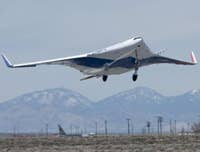NASA’s Blended Wing Body Passes Controllability Test
NASA announced April 6 that its X-48B blended wing body remotely piloted scale model successfully met the challenges of low-speed controllability tests, bringing the quieter, more-efficient transport closer to full-scale reality. The most recent tests of the 8.5 percent scale (21-foot wingspan) 500-pound airplane follow some 80 previous flights and prove its flight computer can handle deliberate excursions from controllability at low speeds. The program is part of NASA’s new Environmentally Responsible Aviation (ERA) project. The project’s manager, Fay Collier, said, “The team has proven the ability to fly tailless aircraft to the edge of the low-speed envelope, safely.” Compared with conventional airliners, NASA believes similar manta ray-shaped aircraft could one day provide operators with higher volume for passengers or cargo, a lower fuel burn and lower noise signature. Tests with the X-48B will continue later this year, as will tests of the X-48C, which has an even lower noise profile than the X-48B.

NASA announced April 6 that its X-48B blended wing body remotely piloted scale model successfully met the challenges of low-speed controllability tests, bringing the quieter, more-efficient transport closer to full-scale reality. The most recent tests of the 8.5 percent scale (21-foot wingspan) 500-pound airplane follow some 80 previous flights and prove its flight computer can handle deliberate excursions from controllability at low speeds. The program is part of NASA's new Environmentally Responsible Aviation (ERA) project. The project's manager, Fay Collier, said, "The team has proven the ability to fly tailless aircraft to the edge of the low-speed envelope, safely." Compared with conventional airliners, NASA believes similar manta ray-shaped aircraft could one day provide operators with higher volume for passengers or cargo, a lower fuel burn and lower noise signature. Tests with the X-48B will continue later this year, as will tests of the X-48C, which has an even lower noise profile than the X-48B.
Key to the latest tests was the aircraft's flight computer and its programmed limiters. Those limiters were tested with deliberate excursions from defined boundaries of controllability at high angles of attack, sideslip and acceleration limits. Eight test flights convinced NASA that the limiters could provide "robust, versatile, and safe control" for blended wing body tailless aircraft. NASA's ERA project hopes to help further the technology before it is transferred to the industry. The X-48B first took flight on July 20, 2007.






